Contents
Far, far away in the meadow grazing … no, not a sheep. Pig Hungarian Mangalitsa is a unique and very interesting breed with curly bristles. From afar, Mangalitsa can really be mistaken for a sheep. Especially if only the back is visible from the grass. Because of the winter down that pigs are covered with for the winter, they are often called the Hungarian downy mangalica, but this is the same breed.
History of origin
Only the fact that the Hungarian Mangalica pig breed was bred by Archduke Josef in 1833 is considered indisputable. Further, the data diverge somewhat. According to the main version, domestic Hungarian pigs were crossed with wild boars, and today at least 50% of Hungarian mangalits carry the genes of wild boars. It is easy to believe in such a version, looking at the photo of this Hungarian mangalica boar.
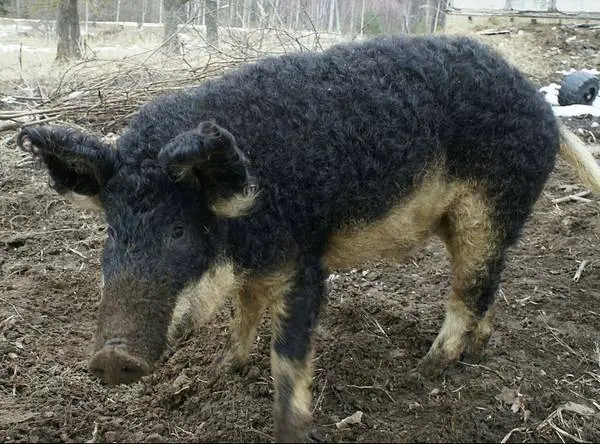
The genes of wild ancestors clearly jumped in it, rewarding the domestic pig with a long snout and erect ears of a wild boar.
The second version of the origin of the Hungarian mangalica breed is somewhat more complicated, although the archduke also appears there. According to this version, Josef received from somewhere as a gift a dozen semi-wild Serbian pigs, of which there were 2 boars. History is silent about what was meant by the word “semi-wild”. Either a mixture with a wild boar, or these pigs simply lived year-round in the forest on grazing and shied away from people.
The resulting semi-wild pigs were crossed with the Mediterranean and Carpathian stock, adding reed pigs from the southeast of Hungary. According to this version, the Hungarian mangalica pig breed was bred only in 1860.

The first version of the origin of the pig breed Hungarian downy mangalitsa refers to Mangal, which was bred by crossing the Carpathian (Hungarian) mangalitsa just with a wild boar.
The parent breeds of pigs from which Mangalitsa was bred had tough fibrous meat and low fat content. This is quite natural for wild pigs, even if they are nominally domesticated. Hungarian mangalicas were not released for free year-round pasture, although they were regularly grazed in the summer, like any other domestic pig.
Due to the calm lifestyle and the presence of movement when walking to and from the pasture, the Hungarian Mangalitsa fattened up the classic marbled meat, where muscle fibers interspersed with layers of fat. Such meat had excellent taste and was highly valued by gourmets of that time.
In the 50s of the last century, a healthy lifestyle and a slim figure began to come into fashion. And the belief that fat is gained by eating lard led to an increase in the consumption of lean meat, and meat breeds of pigs began to displace meat-greasy ones.
As a result, the number of pigs of the Mangalitsa breed has decreased so much that the breed has almost been brought into extinction. And then jamon and lomo became fashionable not only in Spain, but throughout the world. And in the 90s of the last century, it turned out that for the production of these delicacies there was a catastrophic lack of pigs capable of producing marbled meat.
The Spaniards had to take up the revival of the Hungarian mangalica, applying specific care and feeding to obtain quality products. Today, Mangalitsa is no longer an endangered breed of pig, although it is still quite rare.
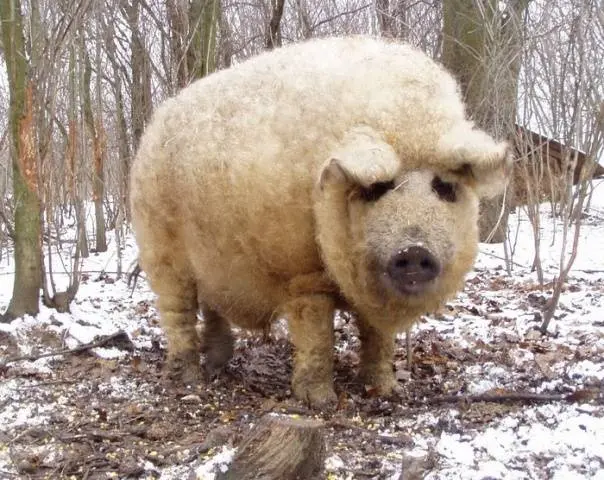
In Hungary, in the 2000s, the Hungarian Mangalica was declared a national treasure and popularized the breed. In addition to productive characteristics, the unusual appearance of the breed was used for advertising, advertising it not only as a Hungarian downy mangalica, but also as curly pigs, which are not found anywhere else. Mangalitsa is quite popular in Ukraine and in the UK. In Our Country, the breeding stock of the Hungarian Mangalitsa is still very small, which is why these pigs are often crossed with other breeds. Crossbred piglets are sold under the guise of purebreds, as the prices for the Hungarian mangalitsa are very high.
Description
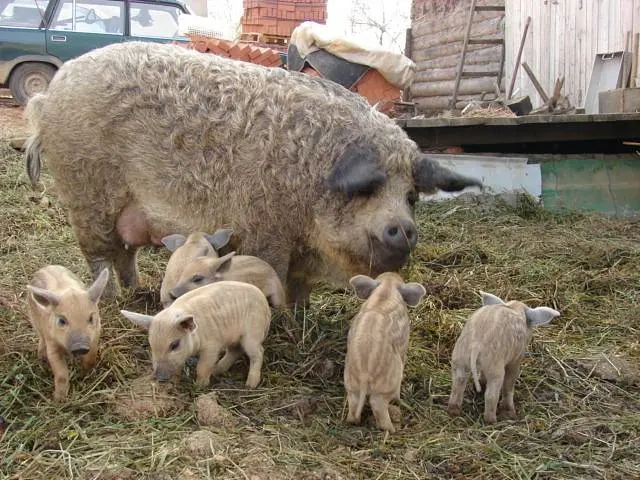
Since the breed of pigs Hungarian mangalitsa belongs to meat-greasy, then its exterior corresponds to this direction. These are pigs with light but strong bones. The format is medium, the body is not as long as that of meat pigs. The head is medium in size, with a curved and relatively short snout. The ears are oriented forward. The back is straight. Sometimes it can be with a slight deflection, but ideally the back should be rounded, from afar it really looks very much like a sheep. The chest is voluminous. The belly should be big.
The description of the Hungarian Mangalica breed states that these pigs should have curly bristles. And from that moment the confusion begins. In some sources, in the description of the Hungarian mangalitsa, it is indicated that her bristles curl only in winter. After the summer molt, the long stubble and down fall out, while the shorter stubble grows straight. According to the reviews of the owners of the Hungarian downy mangalitsa, who bought their Hungarian pigs in a breeding nursery or from a trusted supplier, the bristles of the Mangalitsa should be curly even in summer.
If we compare the photo and description of the Hungarian Mangalitsa breed with the description and photo of the Mangal pig, then there are thoughts that under the guise of the Hungarian Mangalitsa they often write about Mangal. Well, think about it, three letters make all the difference. In fact, these two breeds of pigs are not the same, although they are relatives.
The top photo is of the Hungarian Downy Mangalitsa, the bottom one is of Mangal pigs.
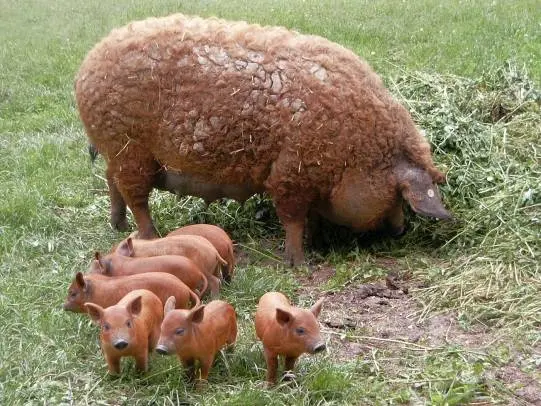

When comparing summer photos of pigs of the mangalitsa and brazier breeds, it is easy to notice that, although the brazier is “woolen”, the pig’s bristles are straight. At Mangalitsa, even in summer, the bristles curl in rings. The Mangal’s ears are often erect rather than pointing forward. The stripes in piglets of the Hungarian Mangalitsa breed can be distinguished in the photo, but you need to look closely, in piglets of the Mangal breed, the characteristic “wild” color is clearly expressed.
Colors and characteristics
Mangalits have 4 color options:
- white;
- red;
- the black;
- bicolor (swallow).
The most common among them is white. Pigs of this color are most often found on farms and private farmsteads. The white suit of pigs is more convenient because after slaughtering and cutting the carcass of a white pig Hungarian mangalica, the dark remnants of bristles in the pigskin will not confuse buyers. For yourself, if you want colors, you can purchase one of the other three options.
In second place in popularity is the color “swallow”. The decorative appearance of a pig with this color attracts many private owners. Often these piglets are not bred for meat, but as pets. True, because of the size they still contain it in a pigsty. In the photo, a pig of the Hungarian Mangalitsa breed of a two-color “swallow” color.
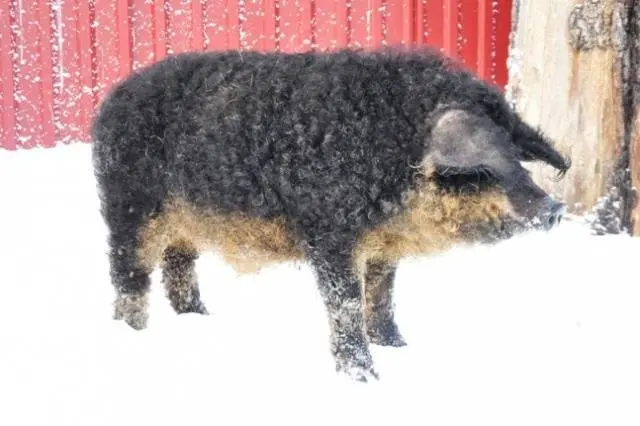
According to early evidence, “swallows” used to be larger than Mangalits of a different color. Now they differ from individuals of other stripes only in shorter and coarser bristles.
Red and black color were at one time very rare and there is information that piglets of this color cannot be bought in private hands. In fact, everything is not so. Perhaps, once upon a time, piglets of these colors were not sold to private traders. Today, all four colors can be found in farmsteads.
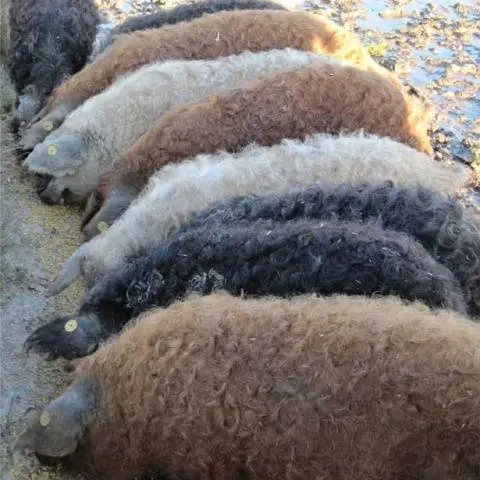
In a professional photo, the red pig Hungarian mangalica looks very impressive. Especially if the pig has a rich color.
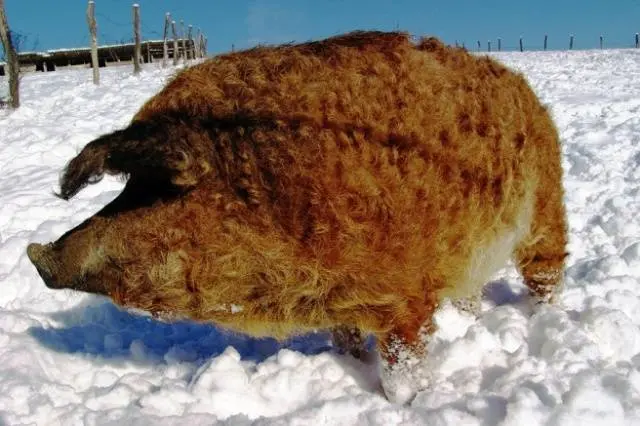
And here is a black Hungarian mangalica for a fan of black colors.


Since Mangal is a hybrid of the Western European boar and Mangalitsa, wild boar traits in this breed often appear.

Signs of purebred
Regardless of the type of color, the skin near the eyes, on the patch, nipples, near the anus and on the inside of the tail should be black. Eyelashes and eyebrows also have black color. The bristles at the tip of the tail and near the patch are black. The skin of the legs is black. There should be no pink spots on the patch.
This spot is called Velman’s spot and is considered the main sign that the pig is indeed thoroughbred. But for some reason, no one takes a photo of Velman’s spot at the Hungarian mangalitsa. Either the pigs are not thoroughbred for everyone, or it’s not such a constant sign.
Productivity
The productive characteristics of the Mangalitsa pig breed are low. The weight of an adult sow is 160-200 kg, a boar – 200-300 kg. The breed is late. Piglets become sexually mature at the age of one year. In the first farrows 4-6 piglets. In a more mature queen, the number of piglets may increase. But farrowing 10 or more young for thoroughbred pigs is considered undesirable and atypical.
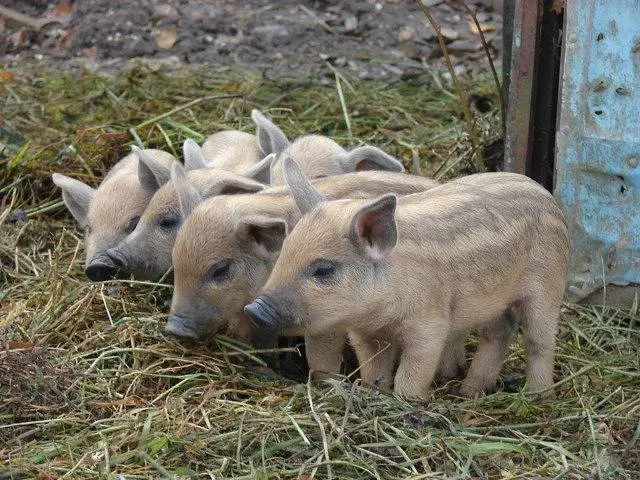
By six months, piglets reach a weight of 70 kg. The layer of fat by the age of slaughter reaches 5,5-6,5 cm. To clarify the weight of a pig without weights, there are specially compiled tables of the ratio of the length of the pig’s body to the girth of its chest. But due to the rarity of Hungarian mangalica pigs, there is no separate size chart for them. But Mangalitsa has a physique similar to other meat-greasy breeds, so you can use the general table.
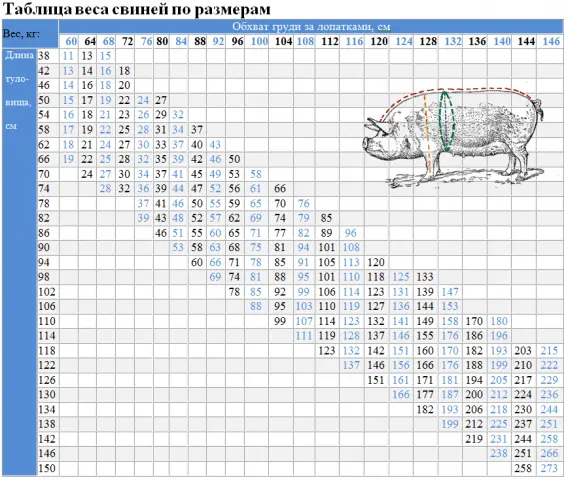
Advantages and disadvantages
According to the reviews of the owners of the Hungarian mangalitsa, its advantages include the ability to winter without a warm pigsty, only under a canopy.
Reviews about the quality of Hungarian mangalitsa meat are usually enthusiastic, but when it comes to the timing of growing pigs of this breed and the amount of production obtained, enthusiasm subsides: other breeds are much more productive.
You can often find negative reviews from the owners of the Hungarian mangalica. But this is not due to the shortcomings of the breed, but to the fact that it is difficult to find a purebred pig. The offspring from a crossbred pig is inferior in quality to producers. Therefore, when a crossbreed is sold under the guise of a purebred Mangalitsa, the appearance of discontent when trying to propagate these crossbreeds is natural.
Maintenance and care
Feeding and maintenance of the Hungarian Mangalica as a whole does not differ from other breeds of pigs. Initially, the breed was bred as “semi-nomadic”, with constant grazing in the open. Therefore, if necessary, Mangalitsa can also spend the winter in the open air, hiding in a haystack like wild relatives. But if winter gains are needed, it is better not to place Mangalitsa in extreme conditions. Today this breed can be kept in three ways:
- in room;
- in a paddock;
- mixed.
Keeping indoors is the standard way of breeding pigs. Because of the thick and warm bristles, it does not fit well for mangalics.
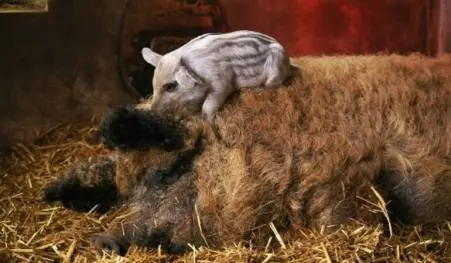
To maintain the thermal balance, Mangalitsa sheds excess bristles indoors, becoming an “ordinary” pig. At the same time, the quality of meat is also deteriorating, since in order to obtain the necessary “marble” it is necessary to select a special diet. In the absence of a sufficient amount of movement, Mangalitsa are prone to obesity. As a result, the content of the Hungarian mangalica becomes much more expensive, and the cost of meat drops to the usual price for lean pork.
Penned for this breed is much better suited. Caring for the Hungarian mangalica with this method of keeping is not difficult. To protect from the cold, it is enough for pigs to build a shelter that imitates a haystack. That is, provide a thick bedding of straw on the floor, and a warm roof on top. If you make a small hole, closed from above and from the sides with bales of hay, as in the video above, such conditions will be enough for the pigs to safely winter.
But only overwinter, not gain weight in the winter. In order for pigs to grow in winter, you need to carefully select how to feed the Hungarian mangalitsa in the cold season. To do this, in winter they must be given warm food. As hot for pigs, porridge is cooked from cereals or swill is made from bran. Food should be warm but not scalding.
When kept in a pen, all pigs are kept together, including newborn piglets. In fact, this is an analogue of keeping rabbits in a pit, but for larger animals.
The mixed type is convenient for keeping sows. Since offspring from pigs are obtained twice a year, one time inevitably falls during the cold season. Therefore, during cold weather, pigs are kept in a barn, and after the onset of heat and the appearance of pasture, they are transferred to pens, grazing on pastures.
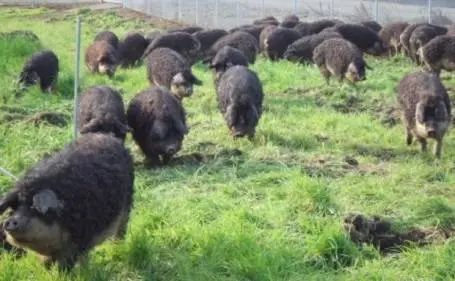
It should be borne in mind that with a large number of pigs and a small pasture area, all vegetation on the pasture will be eaten or trampled very quickly. Artificial grazing must be planted annually with forage grasses and the ratio of the number of pigs / grazing area must be observed: no more than 14 fattening pigs, 6 sows or 74 piglets from weaning to slaughter in 6 months are pastured per hectare.
To avoid diseases, it is necessary to carry out all prescribed veterinary procedures and follow the vaccination schedule.
Feeding
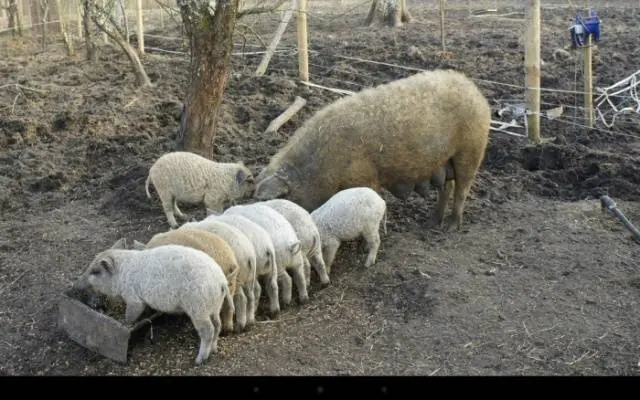
Usually, in the characteristics of Mangalitsa, it is indicated that this is a herbivorous breed and it can be fattened on pasture when grazing in a meadow.
All pigs, without exception, including wild boars, are omnivores. This means that they can eat both plant and animal food. But, not being predators, pigs only kill those who cannot escape from them. Or they eat carrion. The main percentage in their diet really falls on plant foods, which do not have legs. But the grass and roots are good only for sustaining life, these pigs are fattened on grain feed.
In the old days, such situations were very common. Therefore, you should not hope that pigs are herbivores, and leave those who cannot protect themselves next to them.
When keeping pigs for fattening, they must be provided with green fresh grass. Hungarian shepherds still collect these pigs from all over the village every day and drive them out to pasture in the meadows. In addition to grass, pigs are given boiled kitchen waste and boiled porridge. In winter, instead of grass, pigs are provided with hay.
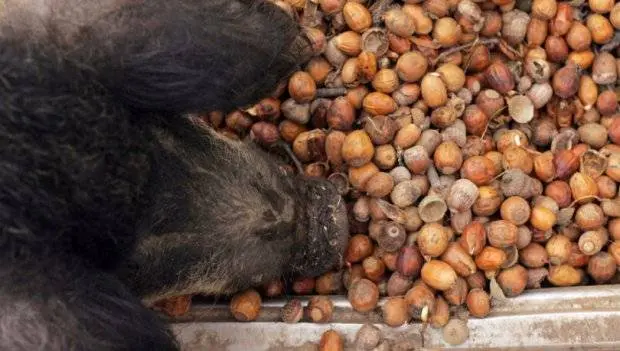
If possible, acorns, root crops, fresh corn cobs, pumpkin, legumes (the whole plant can be used), silage, beer and flour mill waste are added to the diet. Raw potatoes can be given, but undesirable due to possible solanine poisoning. To destroy solanine, it is better to boil potatoes. Also for pigs, brooms are knitted from the branches of hardwood trees and shrubs. But in this case, you need to know the wild flora well. Some shrubs may be poisonous.
The “herbivorous” Mangalitsy will not refuse fish, frogs, snails, insects, worms. You have to be doubly careful here. The most dangerous type of worms for humans is the tapeworm, which uses not only pigs as an intermediate host. It gets into pigs just from snails eaten by animals. The final owner of the pork tapeworm is a man.
In addition to ordinary food, chalk, meat and bone meal and red clay are added to the diet. It is better to put the latter separately and provide pigs with free access to bait.
Also, do not be zealous with table salt. Pigs are very prone to salt poisoning.
It is recommended to add grain feed to the diet of Mangalits 30 days before slaughter and only 300 g per day. But according to the owners of pigs of the Mangalitsa breed, this is not enough. Piglets up to six months require 0,5 kg of grain, adults up to 1 kg.
Breeding
The average gestation period in pigs is calculated using the formula 3 months, 3 weeks and 3 days. In total, this is 114 days. But the period of farrowing can vary from 98 to 124 days. Before farrowing, the sow is transferred to a dry and clean room with a thick layer of straw bedding.
A week before farrowing, the pig’s udder swells and colostrum begins to stand out. But not every queen will allow herself to be felt, so it is easier to navigate by “daily” signs: 24 hours before farrowing or even later, the pig begins to “twist a nest” from the litter. If the pigs are all living together, the queen, ready for interrogation, aggressively kicks out the neighbors. With a relatively small population in the room, she even manages to drive away the rest of the pigs.
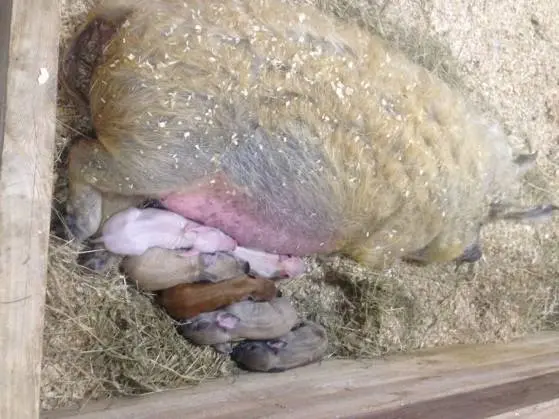
Piglets are born very quickly and immediately go to the nipples. In breed descriptions, Hungarian Mangalica piglets are advised to cut the umbilical cords and disinfect the cut with iodine to avoid umbilical infection.
The idea is good, but only on the condition that the “wild” genes that make sows protect their offspring are not very strong in the pig. Such aggressive pigs are good as queens, but they do not allow you to catch piglets and can tear a person. However, Mangalits have strong enough immunity to deal with the umbilical cords on their own and do without human intervention.
After farrowing, the litter is completely cleaned from the pig. It is believed that this is done so that the sow does not eat the piglets. In fact, a pig that eats piglets immediately goes to meat. And the litter must be cleaned so that the blood and amniotic fluid remaining on the straw do not decompose and do not infect the pig with piglets.
On the 5th day, piglets are pierced with iron-containing preparations to avoid anemia. On the 4th day, the fangs are broken off from above and below with special wire cutters so that they do not injure the pig. But the latter can only be done if the sow allows it.
But with a live pig, piglets will drink milk for more than a month, although they will start trying to eat “adult” food from about two weeks.
The description of the Hungarian mangalitsa indicates that the piglets are born striped.
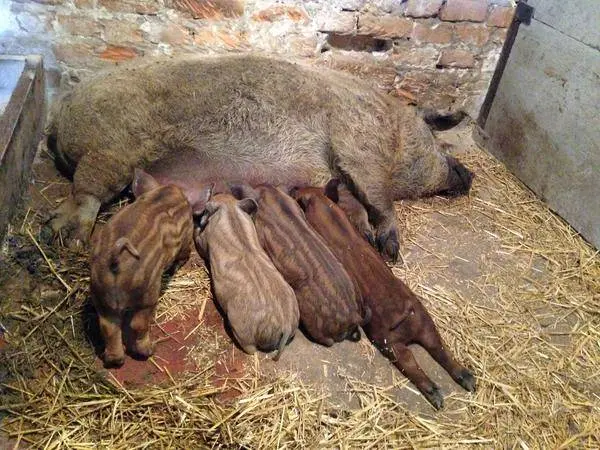
But the stripes of Mangalits are less pronounced than those of Mangals. In addition, piglets do not have curly bristles at birth. Curly piglets of the Hungarian mangalitsa become older than a month old.
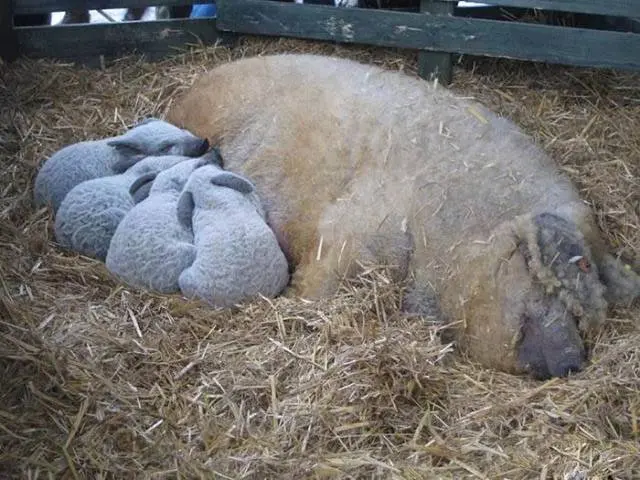
But pigs feed piglets up to 2 months. If there is no need for intensive use of the sow, piglets can be left under the pig until this age.
Feeding piglets
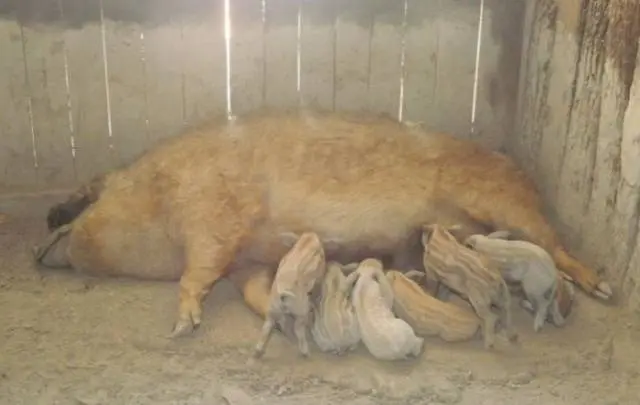
In the very first days of life, piglets eat only pig milk. From 3-5 days you can introduce bait. At this time, the piglets should not yet be given green grass and vegetables. Yes, and solid food at this age, the piglets still do not eat, so what you can feed the piglets of the Hungarian mangalitsa at this age, you will have to finely grind and make a liquid mash that the piglets can suck through the nipple (if the pig does not mind). The mix contains:
- peas;
- roasted barley (barley);
- corn;
- wheat.
From two weeks old, piglets begin to taste the food of adult pigs, and by the month they compete with the sow. The piglets of the Hungarian mangalitsa are taken away after a month, so the question of how to feed the weaned piglets of the Hungarian mangalitsa is not even worth it: the same as adult pigs are fed, but in smaller quantities.
Some details of breeding
With intensive use of pigs for breeding for meat, they happen in the very first hunt after childbirth. But sometimes the pig is not eager to meet the boar again. There can be two reasons why the Hungarian mangalica is not hidden:
- the time of mating has not come;
- disease.
Usually, domestic animals come into hunting on average 10 days after the appearance of the cubs. But pigs are neat in this respect. In the next hunt, the pig comes only 2 months after farrowing.

If you try to mating ahead of time, the pig will refuse to accept the boar. A sign that the pig has come into the hunt is that the “pig gets up”, that is, it does not lie down, as usual, but stands in anticipation of the male.
The second reason is much less pleasant. An accurate diagnosis can only be made by a veterinarian. If a pig lets a boar in, but is single, the reason is most likely hormonal disorders. The disorders may be caused by an ovarian cyst or other problems. Some infectious diseases also cause infertility. Therefore, if a pig is single for no apparent reason, a visit to the veterinarian is necessary.
Reviews
Conclusion
The pig of the Hungarian Mangalitsa breed is able to gain its position in Our Country, thanks to the high-quality meat obtained from the Mangalitsa piglets. Given the interest in this breed of pig owners of private farmsteads, Mangalitsa can spread throughout the Federation. But this takes time.









